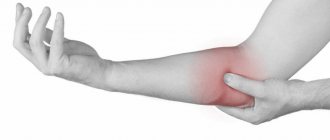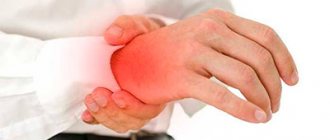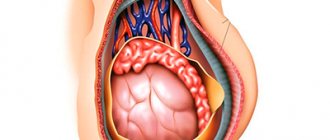Headache occurs in the form of episodic attacks or worries the patient constantly. Attacks of headaches may be accompanied by pain in the eyes, ripples before the eyes, and the sensation of flies flying. These are symptoms of serious diseases that doctors at the Yusupov Hospital identify using modern instrumental and laboratory research methods.
Neurologists, therapists, and oncologists treat patients. Professors and doctors of the highest category at a meeting of the expert council discuss all cases of severe headaches and eye pain that are not amenable to drug therapy. Leading cephalgologists (specialists in the field of headache treatment) collectively develop further tactics for patient management.
Types and causes of pain in the head and eyes
Most often, headaches in the forehead and eyes occur after emotional breakdowns. Many patients experience it in the evening, when the work day ends. In most cases, the cause of pain is simple overwork.
Often the headache radiates to the eyes. Sometimes, first there are ripples in the eyes, then a headache. The eyeballs may first become tense, and then the pain moves to the forehead. Floaters, flickering before the eyes and headache are symptoms of various diseases:
- glaucoma (increased intraocular pressure);
- migraine;
- myopia (myopia);
- arterial hypertension (high blood pressure);
- damage to soft tissues and bones of the head;
- traumatic brain injury.
A headache in the forehead area can occur due to eating unhealthy foods. These are chocolate, tea, coffee, which contain a large amount of caffeine, nuts, cheese, and processed meats. Headache pressing on the eyes after drinking alcohol and smoking. Head pain is caused by the following diseases:
- migraine;
- hypertonic disease;
- diseases of the organs of vision;
- brain tumors;
- Horton's syndrome;
- vegetative-vascular dysfunction;
- encephalitis;
- stroke.
Prevention of eye pain
There are no specific uniform measures to prevent eye pain, since the causes of its occurrence are diverse. To reduce the risk of their occurrence, ophthalmologists advise regular follow-up with them, as well as with doctors of other specializations. The risk of abnormalities that provoke intraocular pain can be reduced by following the general principles of a healthy lifestyle, personal hygiene, and visual hygiene:
- periodically give your eyes rest;
- Use eye protection when working with chemicals, working in contaminated areas or in bright light;
- systematically perform eye exercises;
- use prescription glasses for working with documents and watching TV if you have visual impairments;
- monitor the light level when working with documents, etc.
Patients of any age should consult a doctor immediately after the first unpleasant symptoms appear. This will allow the ophthalmologist to detect the source of the malaise in time and eliminate the problem at an early stage.
How to help yourself with a headache
If a headache radiates to the eyes after hard work, you should rest well, take a walk in the fresh air, and give yourself an acupressure massage. You can take a warm bath with chamomile infusion added to the water. Take a break from working at the computer or watching TV
Give yourself a head massage. Relax, drink warm milk with honey, tea with lemon balm. Do simple exercises to relieve headaches:
- sit on a chair, keep your back straight and your head free;
- without effort, just under the influence of gravity, tilt it towards your chest;
- stay in this position for twenty seconds; take a break for 30 seconds;
- Bend again for 20 seconds.
Repeat the exercise 15-16 times.
The second exercise is done in the following sequence:
- sitting or standing, raise your hands to your head;
- the thumbs of each hand are pressed to the zygomatic arches, with the remaining fingers clasping the back of the head;
- look up;
- while inhaling, try to throw your head back for 10 seconds, while holding it with your hands;
- while exhaling, look down for 6-8 seconds;
- tilting your head to your chest as much as possible, stretch but do not strain the neck muscles.
Repeat the inhale-exhale cycle 5-6 times.
To relieve headaches coming from the cervical spine, rehabilitation experts recommend performing the following exercise:
- sitting on a chair, with one hand clasp your head from above on the side in which the pain is felt more strongly;
- Place the index finger at the level of the beginning of the ear;
- With a little hand effort, turn your head to the “healthy” side;
- Press your free palm from below to your chin and cheek;
- while inhaling for 10 seconds, looking down, press your chin to your lower palm against its resistance;
- As you exhale, relax for 6-8 seconds and look up.
- repeat the exercise 5-6 times, slightly changing the turn of the head.
Gymnastics for eye training
To strengthen the muscular corset of the eye, you need to regularly do eye exercises. On the Internet you can find a lot of different complexes, thanks to which you can significantly improve the condition of the eyeball.
Exercise as often as possible - at work, while walking, before going to bed, or while standing in line.
The more often you practice, the greater the benefits for your eyes. To get the maximum benefit from eye exercises, it is also recommended to do breathing exercises. In addition, you can massage your eyeballs and spend as much time outdoors as possible.
To get a positive effect on the condition of the eye muscles, you should do everything possible to improve blood circulation in apples and have a tonic effect. Due to this, the tissue receives more nutrients and oxygen, which prevents the occurrence of degenerative changes.
It is very important that the set of exercises is developed by a qualified specialist.
Only with a competent approach will it be possible to strengthen muscle tissue, which will prevent the occurrence of painful sensations in the future. Standard eye gymnastics includes the following symptoms:
- Sit up straight and make sure your posture is normal. This will allow blood to flow properly away from the brain. Try moving your gaze from opposite sides 10-15 times.
- Make circular movements with your eyes in one direction, then in the other.
- Try moving your eyes to the extreme points from side to side.
- Try to find an object close by and focus on it for a few seconds. After this, move your eye to the far point and leave focus for the same time.
- For 30 seconds, try blinking quickly and intensely.
Flickering in the eyes and headache
The main cause of flicker in the eyes and headaches is retinal detachment and rupture. Sharp flashes of light are the result of tension in the eye membrane. After a rupture of the capillaries and retina, a person sees many black dots.
Vitreous detachment also causes tension on the retina. It comes in back and front. The vitreous body is divided into a gel and a liquid part, which passes under the membrane and “disconnects” it from the retina. The main sign of the pathology is “flying flies”. They can be seen when looking at the sun, snow in sunny weather, or blue sky.
Chorioretinitis is inflammation of the vessels of the retina of the eye. The development of the disease is caused by:
- infectious diseases;
- increased levels of radiation;
- allergy;
- intoxication;
- injuries and damage to the organs of vision;
- autoimmune conditions;
- decreased immunity after long-term treatment or in HIV-infected patients.
Chorioretinitis can be congenital. Symptoms of the disease include darkening of the eyes and decreased visual acuity. The patient cannot determine the size of objects; it is difficult for him to navigate in low light. Ophthalmologists at the Yusupov Hospital use the latest diagnostic equipment from leading global manufacturers to examine patients and apply innovative treatment methods.
Where does it hurt?
First, the doctor will ask you which area of the eye hurts. Pain can be localized in a variety of places:
- cornea - the transparent membrane through which light passes;
- sclera - the white shell of the eye;
- conjunctiva - a thin film on the surface of the sclera under the eyelid;
- iris - the colored part of the eye surrounding the pupil;
- orbital socket - the depression in the skull where the eyes are located;
- external eye muscles, which are responsible for eye movements;
- nerves that transmit visual information from the eye to the brain;
- eyelids - the outer membranes that protect and moisturize the eye.
Why does my eye hurt?
Main reasons:
- blepharitis - inflammation of the edges of the eyelids when ingested by mites, fungi or bacteria;
- conjunctivitis - inflammation of the conjunctiva due to an allergy or infection caused by a bacteria or virus. Due to infection, the blood vessels of the conjunctiva become inflamed, the eye turns red, and the eyelid begins to itch;
- corneal erosion - injury or damage to the cornea due to a foreign object or mechanical pressure on the eye;
- Keratitis is inflammation of the cornea due to a bacterial or viral infection. Occurs if you do not clean your contact lenses well or do not remove them at night;
- a foreign body in the eye that causes pain and irritation. Usually washed away with tears, but if this does not happen, the foreign body scratches the eye;
- Glaucoma is increased eye pressure due to fluid accumulation in the eye area. If left untreated, you can go blind in one eye;
- Iritis or uveitis is inflammation of the iris or choroid of the eyeball due to injury, infection, or diseases of the immune system. The pain is accompanied by redness of the eye and blurred vision;
- Optic neuritis is an inflammation of the nerve that connects the eye to the brain. The cause of inflammation may be multiple sclerosis. Pain is accompanied by decreased visual acuity and discomfort when moving the eyes from left to right;
- sinusitis - inflammation of the mucous membrane of the paranasal sinuses;
- stye - inflammation of the eyelid as a result of infection in the sebaceous gland or hair follicle;
- chalazion - inflammation of the meibomian gland in the eyelid area;
- dry eye syndrome - a feeling of dryness and burning due to insufficient production of tear fluid;
- migraine - pain behind the eye and in any part of the head, rolling in waves; goes away after the attack stops;
- general fatigue, eye strain - when working for a long time at the computer or with small objects.
Eye spots and headaches
The main reason why a person experiences ripples in the eyes, and then a headache, is the compression of the blood vessels. This happens when the weather changes, atmospheric pressure changes, or oxygen starvation. Floaters “fly” before the eyes and a headache appears after stress. The cause of headaches and dizziness is nervous exhaustion, deficiency of essential substances and microelements, and the presence of bad habits.
In this case, the pain goes away after rest. But ripples and flickering of spots before the eyes, a headache may be the first signs of a tumor, diseases of the cardiovascular system, or vegetative-vascular dysfunction. If, after rest, the ripples and flickering of spots before your eyes, the headache does not go away, make an appointment by calling the Yusupov Hospital. In each case of headache, neurologists first determine the type of pain, identify its cause and eliminate it, stop the pain attack and carry out therapy, the purpose of which is to prevent subsequent headache attacks.
Treatment
The choice of treatment methods depends on the causes of unpleasant symptoms. Tactics can vary significantly in patients experiencing similar symptoms, but having a different list of pathologies.
See what treatment for eye pain is used for various diseases in the table below.
| Disease | Conservative therapy | Surgical/minimally invasive intervention |
| Glaucoma | Instillation of miotic drugs within the first 2 hours after admission to the hospital. Analgesics intramuscularly (diphenhydramine, promedol, aminazine). Intravenous administration of mannitol and glycerol to equalize IOP. | Iridectomy is a laser operation through which the doctor creates an opening between the anterior and posterior chambers of the eye to restore the circulation of intraocular fluid. |
| Ophthalmohypertension | Antihypertensive drugs: ● systemic diuretics; ● inhibitors of VGZ synthesis; ● beta-blockers. Additionally, combined analgesics are used. | Not required. |
| Increased intracranial pressure | Pressure control methods: ● taking diuretics; ● compliance with the drinking regime; ● diet; ● physiotherapy; ● manual therapy. | Shunting is the implantation of shunts (tubes) to drain excess fluid (CSF) from the skull. |
| Optic or trigeminal neuralgia | To relieve pain, a complex of anti-inflammatory, anticonvulsant, sedatives and antidepressants is used. Additionally, physiotherapy, acupuncture, and electrical stimulation are used. | Microsurgical intervention aimed at eliminating compression of nerves. |
| Optic neuritis | Prescribed drugs to eliminate the causes of neuritis: ● antibiotics for bacterial infections; ● antiviral agents for viral inflammation (herpes). Additionally, systemic anti-inflammatory drugs are prescribed, as well as glucocorticosteroids (administered retrobulbarly, that is, inside the eye). | Not applicable. |
| Inflammation of the eyeball | A course of antibiotics and anti-inflammatory drugs of systemic and local action is prescribed. To increase the effectiveness of treatment of inflammation of the eyeball, hormonal drugs are used - prednisolone, hydrocortisone. | Used only in the presence of abscesses. The intervention is carried out in an outpatient setting. The doctor opens the purulent cavity, washes it, and applies a bandage. |
| Cluster headaches and migraines | Therapy is aimed at eliminating headaches and restoring normal vascular tone. Ergotamines, triptans, prescription analgesics, anesthetics, and antiepileptic drugs are used. To improve the condition, physiotherapy and exercise therapy are used. | Not applicable. |
Prevention
Painful sensations in the eye muscles are a serious problem that many people face from time to time. If you feel unwell regularly, you should definitely consult your doctor. Only with the right approach will you be able to get rid of pain once and for all. In addition, we strongly recommend following measures to prevent discomfort:
- Wash your hands thoroughly before touching your eyes. This will help minimize the likelihood of infection.
- Do everything possible to strengthen your immune abilities: harden yourself, spend time in the fresh air, drink vitamin complexes.
- Get checked periodically by a qualified eye doctor.
- Do eye exercises regularly, which will help reduce tension and restore muscle function.
- Avoid eye strain and spend as little time as possible at the computer or TV.
- If you have any problems with your vision or eyes, see a qualified healthcare professional right away.









